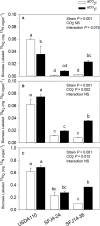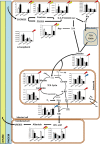Soybean Inoculated With One Bradyrhizobium Strain Isolated at Elevated [CO2] Show an Impaired C and N Metabolism When Grown at Ambient [CO2]
- PMID: 34093614
- PMCID: PMC8173217
- DOI: 10.3389/fpls.2021.656961
Soybean Inoculated With One Bradyrhizobium Strain Isolated at Elevated [CO2] Show an Impaired C and N Metabolism When Grown at Ambient [CO2]
Abstract
Soybean (Glycine max L.) future response to elevated [CO2] has been shown to differ when inoculated with B. japonicum strains isolated at ambient or elevated [CO2]. Plants, inoculated with three Bradyrhizobium strains isolated at different [CO2], were grown in chambers at current and elevated [CO2] (400 vs. 700 ppm). Together with nodule and leaf metabolomic profile, characterization of nodule N-fixation and exchange between organs were tested through 15N2-labeling analysis. Soybeans inoculated with SFJ14-36 strain (isolated at elevated [CO2]) showed a strong metabolic imbalance, at nodule and leaf levels when grown at ambient [CO2], probably due to an insufficient supply of N by nodules, as shown by 15N2-labeling. In nodules, due to shortage of photoassimilate, C may be diverted to aspartic acid instead of malate in order to improve the efficiency of the C source sustaining N2-fixation. In leaves, photorespiration and respiration were boosted at ambient [CO2] in plants inoculated with this strain. Additionally, free phytol, antioxidants, and fatty acid content could be indicate induced senescence due to oxidative stress and lack of nitrogen. Therefore, plants inoculated with Bradyrhizobium strain isolated at elevated [CO2] may have lost their capacity to form effective symbiosis at ambient [CO2] and that was translated at whole plant level through metabolic impairment.
Keywords: Bradyrhizobium strains; C and N metabolism; N-fixation; elevated [CO2]; metabolomics; nodule; soybean.
Copyright © 2021 Soba, Aranjuelo, Gakière, Gilard, Pérez-López, Mena-Petite, Muñoz-Rueda, Lacuesta and Sanz-Saez.
Conflict of interest statement
The authors declare that the research was conducted in the absence of any commercial or financial relationships that could be construed as a potential conflict of interest.
Figures








Similar articles
-
Inoculation with an enhanced N2 -fixing Bradyrhizobium japonicum strain (USDA110) does not alter soybean (Glycine max Merr.) response to elevated [CO2 ].Plant Cell Environ. 2015 Dec;38(12):2589-602. doi: 10.1111/pce.12577. Epub 2015 Jul 28. Plant Cell Environ. 2015. PMID: 26012898
-
Altered exopolysaccharides of Bradyrhizobium japonicum mutants correlate with impaired soybean lectin binding, but not with effective nodule formation.Planta. 2000 Jul;211(2):218-26. doi: 10.1007/s004250000288. Planta. 2000. PMID: 10945216
-
Influence of elevated atmospheric carbon dioxide on transcriptional responses of Bradyrhizobium japonicum in the soybean rhizoplane.Microbes Environ. 2013;28(2):217-27. doi: 10.1264/jsme2.me12190. Epub 2013 May 11. Microbes Environ. 2013. PMID: 23666536 Free PMC article.
-
Divergent metabolic adjustments in nodules are indispensable for efficient N2 fixation of soybean under phosphate stress.Plant Sci. 2019 Dec;289:110249. doi: 10.1016/j.plantsci.2019.110249. Epub 2019 Sep 3. Plant Sci. 2019. PMID: 31623782
-
Impact of glyphosate on the Bradyrhizobium japonicum symbiosis with glyphosate-resistant transgenic soybean: a minireview.J Environ Qual. 2004 May-Jun;33(3):825-31. doi: 10.2134/jeq2004.0825. J Environ Qual. 2004. PMID: 15224916 Review.
Cited by
-
Lemnaceae as Novel Crop Candidates for CO2 Sequestration and Additional Applications.Plants (Basel). 2023 Aug 28;12(17):3090. doi: 10.3390/plants12173090. Plants (Basel). 2023. PMID: 37687337 Free PMC article. Review.
-
Responses in Nodulated Bean (Phaseolus vulgaris L.) Plants Grown at Elevated Atmospheric CO2.Plants (Basel). 2023 Apr 29;12(9):1828. doi: 10.3390/plants12091828. Plants (Basel). 2023. PMID: 37176886 Free PMC article.
References
-
- Ainsworth E. A., Davey P. A., Bernacchi C. J., Dermody O. C., Heaton E. A., Moore D. J., et al. (2002). A meta-analysis of elevated [CO2] effects on soybean (Glycine max) physiology, growth and yield. Glob. Chang. Biol. 8 695–709. 10.1046/j.1365-2486.2002.00498.x - DOI
-
- Ainsworth E. A., Rogers A., Nelson R., Long S. P. (2004). Testing the “source–sink” hypothesis of down-regulation of photosynthesis in elevated [CO2] in the field with single gene substitutions in Glycine max. Agric. For. Meteorol. 122 85–94. 10.1016/J.AGRFORMET.2003.09.002 - DOI
LinkOut - more resources
Full Text Sources

